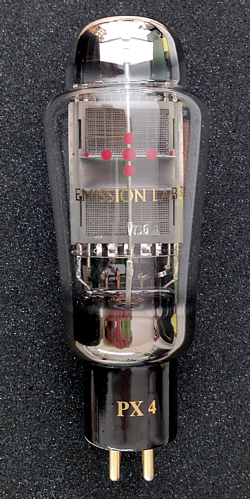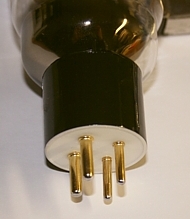PX4 Data Sheet
Description
Guarantee program for first owner.
The first owner can register the tube within 4 weeks after receival, at the Emission Labs website, to participate in the 5 years guarantee program, which is additional to the legal obligations of the seller.
Register here for the 5years guarantee
Features
- Gold Plated Grid
- Soft rubber suspended tube base
- Hard metal Construction (Note1)
- Extra large getters
- Hand blown Glass bulb
- Anti-microphonic Anode- and grid suspension
- These tubes are shipped in a high quality dual box
- Tube printing with 24k gold, and red color burned into the glass
- Gold Plated, black ceramic socket
Description
We quote from the OSRAM data sheet: 'The PX4 is a Directly Heated Power Triode for the output stage of receivers and amplifiers, where a considerable output power is required with a maximum anode (to Grid) Voltage of 300 Volts. For this purpose the tube has exceptionally good characteristics, and is particularly suitable for operating moving coil speakers at large volume without distortion'
Application
In accordance with the historical datasheets, EML PX4 is most suitable for applications for medium output power.
There is some resemblance with the 2A3 or AD1 tube, which can also operate nicely at 250V 60mA, same as the PX4. Yet PX4 is a tube with somewhat higher impedance character, positioned somewhere in between 45 and 2A3. This makes it a very good tube for high efficiency loudspeakers, similar to what OSRAM wrote already, now almost 100 years ago.
Filament / Heater
The EML PX4 uses a heater current of 1.6 Ampere, vs. only 1 Ampere for the historical tubes. The EML heaters are specially constructed to have lowest possible hum, which is lower than historical tubes. For best results we recommend DC heating. This becomes increasingly important if a tube is used for very high efficiency loudspeakers. Please note, for all directly heated tubes, the best DC heater schematic is using the same as for AC, and apply DC voltage to it, instead of AC.
Anode dissipation
Very early types had 12 Watt Anode dissipation. Later types were upwards compatible, and had 15 Watt dissipation. These can be recognized by the working points of 15 Watt in the datasheet such as 300V 50mA and 250V / 60mA. These 12 Watt tubes and 15 Watt tubes have essentially the same tube curves, but of course you will see other recommended bias resistors in old data sheets, to achieve 12 Watt or 15 Watt dissipation.
Correct Bias
The EML PX4 is intended to be upwards compatible with original Osram / Marconi tubes, with the only difference being the higher heater current of the EML. By OSRAM, the PX4 was designed for low to medium Anode voltage, and indeed the tube works best with the Anode voltages as specified in the data sheet. As the Anode voltage is relatively low, it is recommended to use a classical auto bias circuit, as this keeps the cost and construction effort low. Unlike the historical tubes, the EML tubes have some hidden reserve as you can see from the Peak Anode Dissipation of 17 Watt. This makes it possible to bias the tube in idle at maximum 15 Watt indeed, whereas under peak signal level, the dissipation may shift up for a short time to the peak level 17 Watt.
On the other hand, you can take any PX4 amplifier designed for OSRAM tubes, and replace those by EML PX4, and bias will be the same, but care should be taken, the amplifier can deliver the higher heater current of the EML.
EML PX4 Filament Ratings |
|
Filament Voltage Important: See notes at page bottom
|
= 4 Volt (AC or DC) |
| Tolerance on filament voltage | 5% |
| Filament Current | 1.6 Ampere |
EML PX4 Maximum ConditionsNot possible simultaneously |
|
Anode Voltage, Working point |
400Volt |
Anode Current |
80mA |
| Peak Anode Dissipation | 25Watt |
Anode Dissipation Continuous |
18Watt |
Highest possible Grid to ground resistor, Single Ended. |
250k Ohm Original OSRAM 500k Ohm possible for EML |
Highest possible Grid to ground resistor, Push-Pull. |
50kOhm |
EML PX4 Test conditions |
|
| Anode Voltage | 250V |
| Anode Current | 48mA |
EML PX4 Test Result |
|
| Grid Voltage, AC Heated | -35.1V |
| Grid Voltage, DC Heated | -33.1V |
| * For testing, the grid voltage has to be adjusted, until plate current is 48mA. Then, measure tube data. | |
EML PX4 Operating Single Ended, Class A | ||
| Supply Voltage | 350V |
350V |
| Anode Voltage | 300V |
250V |
| Anode Current | 50mA |
60mA |
| Bias Resistor | 1k |
600R |
| Load Resistor (Ra) | 3k5 |
3k |
| Output Power | 4.5Watt |
3Watt |
| Distortion | 4.3% |
2,8% |
| Input Signal | 36.5V rms |
26V rms |
| Gain (Mu) | 4.6
|
4.5
|
| Transconductance (Gm) | 5.3mA/V |
5.6mA/V |
| Anode Impedance (Rp) | 875R
|
800R
|
| Possible Lundahl transformers | LL1620-060 3k3 to 4/8/16 Ohms |
LL1664-060 3k to 8Ohms |

EML PX4 tube curves, DC heated.
Curves with Sofia Curve tracer
EML PX4 Mechanical Data |
|
|
Size including Socket
Pin 1: Heater1 Weight of one tube: Shipment weight for pair in gift box: |
| UX4 Base | |
Notes
- Hard-metals can be used in electron tubes, though these are more difficult to use, and more costly than classic nickel. Hard metal Anodes have a more precise Anode distance, and do not change shape when heated, or at mechanical shock. This ensures reproducible tube parameters, and long term stability. Wolfram grids allow the most precise grid wire distance, because wolfram is an extreme hard metal. Best grid geometry ensures uniformity and linearity of the tube curves.
- Individual Test data, such as: Matching Data, Grid Current, Vacuum, Filament Current, etc., are on the Certificate that is on the outside of the tube box. Each tube is numbered from the inside, with a metal Tag
- Average Plate Characteristics are made with the Sofia Digital Curve tracer.
- Some of our competitors claims to be the only one with a Center Tapped filament, but at EML we build since many years all tubes Cathode Tapped, not just this tube.
- Do not experiment with lower filament voltage, to expect better lifetime. We already specify filament voltage for the best lifetime.
- Gold Plated grids have a few advantages, such as increased bias stability, some protection against accidental overload, and better linearity of tube curves.
- Heater voltage is always defined at the tubes pins itself. There may be some voltage drop along the wires, and tube contacts as well. So voltage measured at the tube socket wiring should ideally be 0.1V higher.


